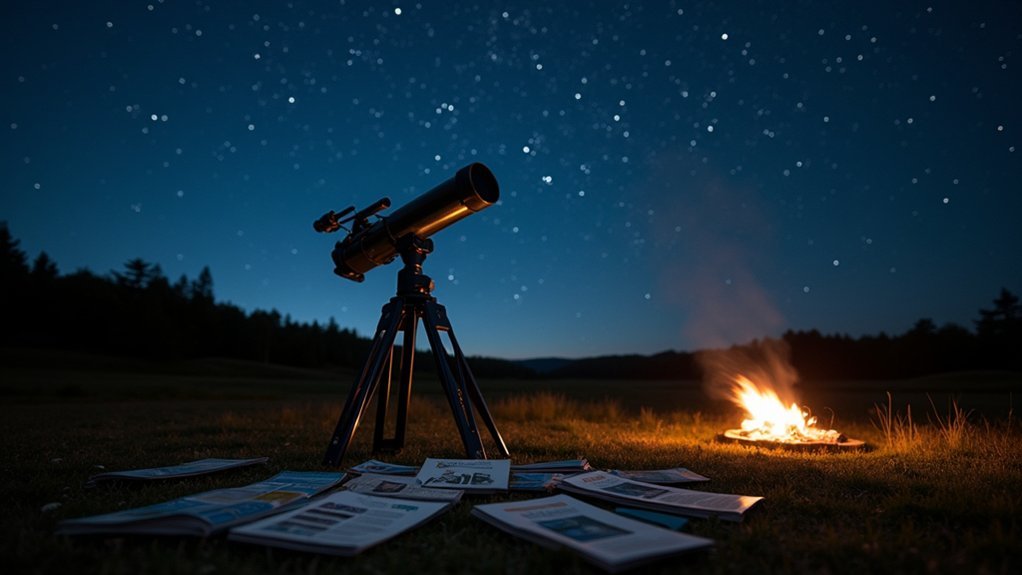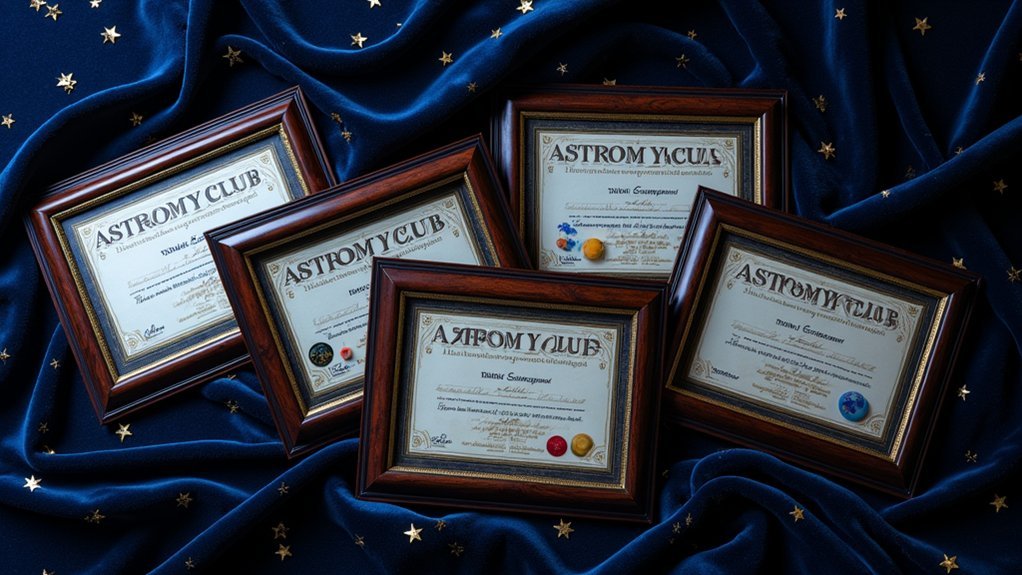To convert star coordinates, you’ll need to understand Right Ascension (RA) and Declination (Dec). For RA, multiply hours by 15 to get degrees (10h = 150°). For Dec, simply add degrees, minutes/60, and seconds/3600 (like +11° 58′ 02″ = +11.967°). Use smartphone apps as portable planetariums or align physical star charts with your current time and location. Start with bright stars as reference points. These basic conversion skills will open up the entire celestial sphere for your exploration.
Converting Star Coordinates: Simple Methods For Beginners

When you’re first learning to navigate the night sky, understanding how to convert between different coordinate systems is essential. Celestial coordinates use two measurements: Right Ascension (RA) and Declination (Dec).
Mastering celestial navigation begins with understanding coordinate systems that map our vast universe.
To convert RA from its standard hours:minutes:seconds format to decimal degrees, multiply the hours by 15 (since each hour represents 15° of angle). For example, Regulus at RA 10h 08m 22.2s converts to about 152.9°.
For Declination, the formula is straightforward: degrees + (minutes/60) + (seconds/3600). Positive values indicate positions north of the celestial equator, while negative values point south.
When working backward from decimal degrees to standard format, divide by 15 for RA to get hours, then calculate the remaining minutes and seconds for precision.
Understanding Right Ascension and Declination Basics
To read star maps effectively, you’ll need to understand the two fundamental celestial coordinates: Right Ascension (RA) measured in hours eastward from the vernal equinox, and Declination (Dec.) measured in degrees north or south of the celestial equator.
Think of these coordinates as similar to longitude and latitude on Earth, with RA functioning as your celestial longitude (measured in time units where 1 hour equals 15 degrees) and Dec. as your celestial latitude.
You can locate any star, planet, or deep sky object once you’ve mastered these coordinates, which form the foundation of all astronomical navigation systems.
Celestial Coordinate Basics
Although exploring the night sky might seem intimidating at first, understanding the celestial coordinate system will give you a reliable framework for locating any object in the heavens.
This system uses two primary measurements: Right Ascension (RA) and Declination (Dec).
RA functions like longitude but is measured in hours (0-24), with each hour spanning 15° of the celestial sphere. Dec works similarly to latitude, measuring degrees north (+) or south (-) of the celestial equator. Together, they provide unique coordinates for all celestial objects.
You’ll notice these coordinates remain relatively stable over short periods, changing only gradually due to Earth’s axial precession. This stability makes them invaluable for navigation and observation planning.
Even when two stars share the same Dec, they’ll have different RA values, ensuring each has a unique address in the sky.
Reading Star Maps
Now that you’re familiar with the celestial coordinate system, let’s apply this knowledge to reading star maps effectively.
Think of Right Ascension (RA) and Declination (Dec) as the celestial version of longitude and latitude. When you’re exploring star maps, these coordinates serve as your cosmic GPS.
- RA coordinates running horizontally across your star map (measured in hours, minutes, seconds), with each hour spanning 15 degrees of sky
- Dec coordinates extending vertically (measured in degrees), with +90° at the north celestial pole and -90° at the south pole
- Gridlines on star maps intersecting to create a framework that pinpoints exact stellar positions
- Seasonal star maps rotating based on RA to show which stars are visible during specific months
You’ll find that mastering celestial coordinates transforms your stargazing experience from random scanning to purposeful exploration.
The Relationship Between Earth and Celestial Coordinates

When traversing the night sky, you’re fundamentally translating between two coordinate systems: Earth-based and celestial.
The celestial coordinate system mirrors our terrestrial grid through Right Ascension (RA) and Declination (Dec). RA functions like longitude but measures in hours (0-24h), with each hour representing 15 degrees of angular distance from the vernal equinox.
Dec operates similarly to latitude, with the celestial equator serving as the 0° reference point. Positive declination values indicate positions north of the celestial equator, while negative values represent southern positions.
While Earth’s coordinates remain fixed relative to our planet, celestial objects appear to move due to Earth’s rotation. Your ability to locate stars depends on converting between these systems—the fixed RA and Dec coordinates remain consistent, while local coordinates (altitude and azimuth) change based on your location.
Converting Between Hours and Degrees in Right Ascension
Converting between hours and degrees in Right Ascension follows a straightforward formula: multiply RA hours by 15 to get degrees, or divide degrees by 15 to get hours.
You’ll find this process essential when working with astronomical software that requires different coordinate formats, as in the example where 5h 30m 0s converts to 82.5° (5h × 15°/h + 30m × 0.25°/m).
Watch out for common mistakes like forgetting to convert minutes and seconds to their degree equivalents or mixing up the direction of conversion when working with celestial coordinates.
Basic Conversion Formula
The fundamental relationship between time and angular measurement lies at the heart of Right Ascension (RA) conversions. When you’re plotting celestial objects, you’ll need to convert between hours and degrees frequently.
The basic formula is straightforward: multiply hours by 15 to get degrees, or divide degrees by 15 to get hours.
- A star at 8 hours RA sits at 120° on the celestial sphere (8 × 15 = 120°)
- The Andromeda Galaxy at 10.68° converts to 0.712 hours RA (10.68 ÷ 15)
- Minutes of RA convert at 0.25° per minute (3 minutes = 0.75°)
- Seconds convert at 0.00416° per second (30 seconds = 0.125°)
You can quickly master these conversions with practice, making your star charting more efficient and accurate.
Practical Worked Examples
Now that you understand the basic conversion principles, let’s examine some practical scenarios you’ll encounter while working with celestial coordinates.
When locating a celestial object with RA of 3h 45m 30s, you’ll need to convert to degrees: 3 hours × 15 = 45°, plus (45/60) × 15 = 11.25°, plus (30/3600) × 15 = 0.125°. This equals 56.375° total.
Conversely, if your star atlas shows a coordinate system in degrees (e.g., 78.5°), divide by 15 to get hours: 78.5° ÷ 15 = 5.23 hours.
Convert the decimal to minutes: 0.23 × 60 = 13.8 minutes, and the remaining decimal to seconds: 0.8 × 60 = 48 seconds.
Common Calculation Pitfalls
Many amateur astronomers stumble when converting between hours and degrees in Right Ascension calculations, leading to significant positioning errors.
When working with the celestial sphere, you’ll need to master these conversions to accurately locate objects.
Watch out for these common mistakes:
- Forgetting that 1 hour of Right Ascension (RA) equals exactly 15 degrees, not 60 degrees as you might intuitively assume
- Mixing up the conversion formula: use (hours × 15) + (minutes × 15/60) + (seconds × 15/3600) for complete accuracy
- Failing to maintain proper units throughout your calculations, especially when working with mixed hours, minutes, and seconds
- Neglecting to verify your answer makes sense within the 360-degree/24-hour framework of the complete celestial sphere
Double-check your conversion work to guarantee precise star positioning.
Using Star Charts to Locate Celestial Objects
After learning about celestial coordinates, you’ll need practical tools to apply this knowledge in stargazing. Star charts display celestial objects using RA and Dec coordinates, helping you identify constellations and stars in the night sky.
To use a star chart effectively, align it with the current date and time, then match its orientation to your actual view. Most charts place north at the top, but you’ll need to rotate it according to your horizon. Remember that star positions shift throughout the year as Earth orbits the Sun.
Star charts must be aligned to time and position, with north at top adjusted to your horizon view as seasonal changes occur.
Locate bright stars and major constellations first as reference points, then navigate to fainter objects. Many charts include labeled celestial coordinates, connecting the RA and Dec system to visual positions.
This practical approach bridges the gap between abstract coordinates and real stargazing.
Simple Tools for Measuring Angular Distances

While celestial coordinates provide a theoretical framework, you’ll need practical ways to measure angular distances in the night sky. You can use several everyday items as makeshift tools for estimating the separation between stars without specialized equipment.
- Your fist held at arm’s length spans approximately 10 degrees, perfect for measuring larger gaps between constellations.
- A pinky finger width covers about 1 degree, ideal for precise star-to-star measuring.
- A protractor or digital angle finder offers more accurate readings when comparing to star charts.
- Modern telescopes with setting circles provide the most precise angular distance measurements.
These simple techniques help bridge the gap between theoretical coordinates and practical star-hopping. When combined with detailed star charts, these measuring methods transform abstract celestial positions into tangible visual relationships you can observe directly.
Converting Altitude and Azimuth to RA and Dec
Converting altitude and azimuth coordinates to Right Ascension and Declination requires understanding your local position and time.
You’ll need your latitude and local sidereal time to apply trigonometric formulas that transform horizon-based measurements to celestial equivalents.
The conversion process accounts for Earth’s rotation by calculating Declination through sine and cosine functions, while RA determination involves adjusting for your specific time and location on Earth.
Converting Altitude and Azimuth to RA and Dec
Once you’ve measured a star’s position in your local sky using altitude and azimuth coordinates, you’ll often need to translate these into the universal celestial coordinates of right ascension (RA) and declination (Dec).
To make this conversion, you’ll need:
- Your geographical latitude – essential for accounting for your specific position on Earth
- Local sidereal time – the “star time” that affects where celestial objects appear
- The formula: RA = LST – (Azimuth / 15)
- The formula: Dec = arcsin(sin(Latitude) × sin(Altitude) + cos(Latitude) × cos(Altitude) × cos(Azimuth))
Remember to convert your azimuth measurements from degrees to radians before performing calculations.
Confirm your altitude readings fall between 0° and 90° for valid results. Understanding spherical trigonometry will help you visualize how these coordinates relate on the celestial sphere.
Understanding Local Coordinates
Before you can accurately convert between coordinate systems, you’ll need to thoroughly understand your local altitude-azimuth framework. Your position on Earth defines how you observe celestial objects, with altitude measuring the angle above your horizon (0° to 90°) and azimuth indicating direction from true north (0° to 360°).
To convert these local coordinates to the universal Right Ascension (RA) and Declination (Dec) system, you must account for your latitude and longitude and local sidereal time.
The declination can be calculated using the formula: Dec = arcsin(sin(Alt) * sin(Lat) + cos(Alt) * cos(Lat) * cos(Az)).
For RA, you’ll need to determine the Hour Angle first, which relates to your local sidereal time.
Tools like Stellarium simplify these calculations, allowing you to track celestial objects regardless of your location.
Basic Conversion Formula
The mathematical relationship between your local coordinates and the universal celestial grid can be expressed through specific conversion formulas.
To convert altitude and azimuth to right ascension (RA) and declination (Dec), you’ll need to apply these calculations:
- For declination: arcsin(sin(altitude) × sin(observer latitude) + cos(altitude) × cos(observer latitude) × cos(azimuth))
- For RA: arctan(sin(azimuth)/(cos(azimuth) × sin(observer latitude) – tan(altitude) × cos(observer latitude)))
- Remember to convert your observer latitude to radians before calculation.
- After calculating RA in degrees, divide by 15 to convert to hours.
These formulas account for your specific location on Earth and transform your local horizon-based coordinates into the universal equatorial system astronomers use worldwide.
Smartphone Apps for Coordinate Conversion
As you navigate the night sky, smartphone apps have revolutionized the way amateur astronomers convert and utilize celestial coordinates. These tools transform your device into a portable planetarium, instantly converting between coordinate systems using your GPS location.
You’ll find apps that allow direct input of Right Ascension (RA) and Declination (Dec) values to pinpoint specific celestial objects, while others offer augmented reality views to visualize stars in real-time.
| App Name | Key Features | Coordinate Systems |
|---|---|---|
| Star Chart | AR sky viewing | RA/Dec, Alt/Az |
| Sky Map | Real-time tracking | RA/Dec, Alt/Az |
| Stellarium Mobile | System toggling | Multiple systems |
| SkySafari | Built-in calculators | Degrees/Hours conversion |
These coordinate conversion tools make astronomy more accessible, eliminating complex calculations while you explore the cosmos.
Hand Calculations for Quick Coordinate Estimates
While smartphone apps offer convenience, mastering hand calculations gives you independence under starry skies when technology fails. Converting star coordinates by hand isn’t difficult once you understand the basic formulas.
For Right Ascension (RA), multiply hours by 15 to get decimal degrees, since each hour equals 15 degrees of celestial arc. For Declination (Dec), simply add degrees, arcminutes/60, and arcseconds/3600, keeping negative signs for positions south of the celestial equator.
- Picture yourself at a remote observing site, calculating RA as Earth rotates beneath the stars.
- Imagine tracing declination lines from the celestial poles across the night sky.
- Visualize decimal degrees as smooth coordinates on your star chart.
- See yourself quickly estimating angular separation between two stars using spherical trigonometry.
Seasonal Adjustments for Star Positions
Because Earth orbits the Sun throughout the year, you’ll need to make seasonal adjustments when locating specific stars. The visibility of stars changes predictably as our planet moves through its annual cycle, affecting which constellations you can observe each month.
Stars’ positions are defined by their right ascension and declination coordinates, but their actual visibility depends on your season. Stars north of the celestial equator become more prominent during winter months in the Northern Hemisphere, while southern stars dominate summer skies.
Stars have fixed positions in the heavens, but your viewing window shifts with Earth’s seasons.
For example, you’ll find Orion easily in winter, but must wait until summer to see Scorpius clearly.
Use season-specific star charts for your location to determine which stars will be visible. These charts account for seasonal changes and help you pinpoint celestial objects accurately throughout the year.
Practical Examples of Coordinate Conversion
Understanding coordinate conversion becomes clearer when you work through actual examples.
Let’s explore how you’ll convert between sexagesimal notation and decimal degrees for both Right Ascension (RA) and Declination (Dec).
To convert RA from hours to degrees, multiply hours by 15, then add minutes/4 and seconds/240. For Dec, simply add degrees, minutes/60, and seconds/3600.
- Convert 10h 08m 22.2s RA to approximately 152.1 degrees by multiplying 10×15 and adding fractional parts.
- Transform +11° 58′ 02″ Dec to +11.967 degrees by adding 11 + (58/60) + (2/3600).
- Convert 213.91317 degrees back to RA: 14h 15m 38.0s by dividing by 15.
- Change +19.17897 degrees to Dec notation: +19° 10′ 44.4″ using the remainder method.
Common Mistakes and How to Avoid Them
Now that you’ve seen practical conversion examples, let’s address the pitfalls that can trip up even experienced astronomers. When working with star coordinates, precision matters tremendously.
| Common Mistake | Consequence | Solution |
|---|---|---|
| Confusing units | Missing your target by degrees | Remember: 1 hour RA = 15 degrees |
| Incorrect format conversion | Significant positioning errors | Convert 10h 08m 22.2s properly to decimal |
| Ignoring local sidereal time | Unable to locate stars | Adjust RA calculations for your current LST |
| Misinterpreting coordinate layout | Confusing similar stars | Verify both Right Ascension and Declination |
You’ll save yourself frustration by double-checking your calculations with reliable tools. Many beginners overlook these details, but awareness of these common errors will dramatically improve your stargazing accuracy and enjoyment.
Tracking Objects Across the Night Sky
While mastering coordinate conversions gives you the foundation, successfully tracking celestial objects as they move across the night sky requires an additional set of skills. Understanding Right Ascension (RA) and Declination (Dec) creates a framework, but you’ll need to translate these fixed coordinates into real-time positions.
- Picture Earth’s rotation causing stars to arc overhead—rising in the east and setting in the west while maintaining their Dec paths.
- Visualize the Hour Angle changing throughout the night as celestial objects drift westward relative to your local meridian.
- Imagine your star maps as snapshots of the sky that you must mentally animate based on time and season.
- See yourself adjusting your telescope’s setting circles as you follow an object’s journey from horizon to horizon.
Remember to update your tracking methods as Earth orbits the Sun, changing which celestial objects are visible each season.
Frequently Asked Questions
How to Use Coordinates to Find a Star?
To find a star, you’ll need its RA and Dec coordinates. Adjust your telescope using these values—RA for east-west position (15° per hour) and Dec for north-south position from the celestial equator.
How Are Star Coordinates Determined?
Star coordinates are determined using Right Ascension (measured in hours eastward from the vernal equinox) and Declination (measured in degrees from the celestial equator). You’ll find these form a universal system astronomers use worldwide.
Can the Coordinates for a Star Change?
Yes, star coordinates do change. You’ll notice slow shifts due to Earth’s axial precession (about 50 arcseconds yearly) and the star’s proper motion through space, though they remain stable enough for everyday observations.
Is There an App to Find a Star by Coordinates?
Yes, you’ll find several apps like SkySafari and Stellarium that let you enter celestial coordinates (RA and Dec) to locate stars. They use your phone’s sensors for real-time sky viewing through augmented reality.
In Summary
You’ve now learned how to navigate the night sky using celestial coordinates. Remember that converting between right ascension and degrees isn’t complicated once you’ve practiced. Don’t worry if you make mistakes at first—everyone does! Keep your star charts handy, adjust for seasonal changes, and soon you’ll track objects confidently across the heavens. Your stargazing adventures are just beginning!





Leave a Reply